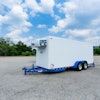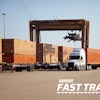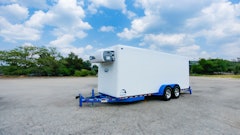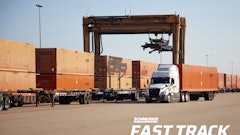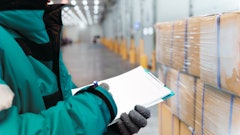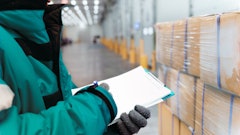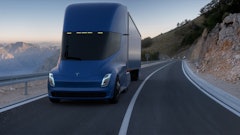
Walking around the streets of Kansas City, no one would suspect that an entire subterranean world exists beneath their feet. And yet for close to 50 years now, that’s been the case. Food companies have been in on the secret for a long time and take full advantage of all the benefits underground storage has to offer.
Why Kansas City? It all goes back to the large deposits of limestone the city has beneath it. “This is the greatest concentration of limestone in the country by a long shot,” explains Tony Kraus, president of Space Center Distribution, a third-party logistics warehousing company with a substantial amount of developed underground space. “The type of limestone in this area is very hard, so it makes for a great natural location for underground commercial space.”
In the case of real estate developer Hunt Midwest, which owns and operates SubTropolis, the largest underground business complex in Kansas City, their mining company first began drilling for limestone in and around the city back in the mid-1940s. By the 1960s, they came up with the concept of developing commercial space in the same area. “When they were mining, they would leave pillars in random paths throughout the space,” explains Dick Ringer, assistant general manager for real estate developer Hunt Midwest.
“They realized that it would be perfectly suited for commercial space if they arranged the pillars into straight lines. Now there is 40 ft. in between all of the pillars to accommodate business and warehousing structures.”
Because Kansas City has such a rich, natural environment for underground storage, it has become the nation’s leader in this type of space. “There’s a big knowledge base here,” says Paul Licausi, president of LS Commercial Real Estate. “We have developed the best methods for subsurface development and many people come here seeking guidance.”
Originally, underground space was viewed as a good idea because of the cost savings it offered. Today that’s still a big benefit, but now a myriad of factors make underground storage ideal for a variety of companies, especially those in the food industry. “The cost savings brings people down,” says Ringer, “but they stay for a whole host of reasons.”
What Makes It Appealing
Kansas City’s underground storage facilities offer a wide variety of benefits, beginning with cost. Lease rates, for instance, tend to run 30 percent to 50 percent less than in comparable above ground facilities. Utility costs are also lower—around 50 percent to 70 percent in total energy costs.
Another benefit is tax savings, according to Ringer. “Below ground, we’re charged about 30 cents per square foot in taxes,” he explains. “Above ground that can run anywhere from $1 to $1.60 per square foot in comparison.”
The cost of constructing space underground is also less expensive, according to Kraus. “Overall, construction costs can run about a third cheaper than above ground space,” he explains. “This is savings we can pass on to the customer.”
Beyond cost savings, the underground facilities have other advantages. For one, the temperature remains at a constant 68 degrees to 72 degrees year round. In the underground freezer buildings, SubTropolis is able to freeze the rock so that there is a permafrost around the freezer buildings, keeping the temperatures at a constant cool temperature.
“Here in Kansas City, the weather can vary from single digits in the winter time to 100 degrees in the summer,” says Licausi. “But underground remains constant.”
According to Licausi, that translates into several benefits. “For employees, it means that they are in a very comfortable temperature range at all times, which helps with productivity,” he says. “Underground you don’t have to worry about outside weather, so things like snow or heat or rain aren’t going to impact your operations.”
The constant temperature also equates into a big utility savings. For example, one Hunt Midwest tenant has reported a $50,000 monthly savings during the winter months compared to heating similar above-ground buildings.
For food companies, this constant temperature also means food and packaging integrity. “Not only is the temperature constant, but the humidity level is maintained at below 55 percent,” says Kraus. “This is great for food and packaging materials.”
Ringer points out that the constant conditions underground also add to the cost savings. “Many times you have to condition the space you store food in, but not so here for many products,” he says. “That translates into inexpensive storage. SubTropolis has a massive on-site freezer available for tenants at a fraction of the cost of above-ground options.”
In addition, being underground means that stored food is completely immune from the elements. “We have a solid rock roof down here,” says Ringer. “That means that there are no water leaks to worry about. Companies can store perishables, dry goods and even freezer goods without having the concern that they may be harmed in storage.”
Foodservice distributor Paris Bros., for instance, found the environment ideal for storing green coffee. The temperature, humidity and complete lack of influence from outside elements created the perfect set of conditions.
“We have customers that find their products have a longer shelf life by being down here,” says Licausi. “That’s a nice appeal.”
Of Space Center’s 6.5 million sq. ft. of developed space, which is shared by light manufacturing, printing operations, record storage, and different types of warehousing, Kraus estimates that about 950,000 sq. ft. of the company’s underground space is dedicated to food warehousing.
Ringer puts Hunt Midwest’s food storage occupancy at around 800,000 sq. ft. of the five million sq. ft. it has available. “We have room for adding another eight million sq. ft.,” he points out. Licausi says that LS’s space is about 80 percent occupied by food companies.
The Original Green Building
All of the developers/leasers of Kansas City’s underground space consider it to have been “green” long before it was trendy. They point to several reasons for this:
• Fewer building materials are needed to construct the buildings, which conserves natural resources;
• Underground buildings do not add to storm-water runoff or light pollution;
• The underground location reduces energy consumption;
• Worker productivity is increased due to the consistent comfortable environment;
• Naturally secure limestone environment is three times stronger than concrete, which protects tenant assets and lowers insurance costs.
“The green factor holds a lot of appeal to potential clients today,” says Ringer. “The structure and floor are already in place, so this space requires few materials and little manpower to put together. That’s a big draw.”
Many companies seeking that green aspect to their operations find that the underground space allows them to do it without adding to their expenses. Rather than outfitting traditional above-ground buildings, tenants enjoy zero energy consumption for heating and minimal for cooling.
The underground space’s central location is also a bonus. Roadways in the underground accommodate 18-wheelers and some facilities have rail spurs that feed directly into them. Numerous intermodal facilities are also close by. Not only do these features allow companies to easily ship product all over the country, but its proximity to so many parts of the country means that less fuel is required to transport products to customers.
If there is any drawback to underground storage, it’s that the ceiling height runs lower than in above-ground counterparts. Still, Ringer says the pros far outweigh the perception that ceiling height is a limitation and that many customers end up expanding their square footage and repeatedly extending their contracts.
“We have tenants that have been here since the ’70s. Once people get down here, they rarely leave. If they do, it’s because they are leaving the market,” says Ringer.


